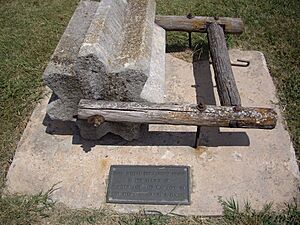Goessel, Kansas facts for kids
Quick facts for kids
Goessel, Kansas
|
|
|---|---|
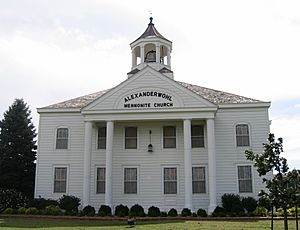
Alexanderwohl Mennonite Church
1 mile north of Goessel (2007) |
|
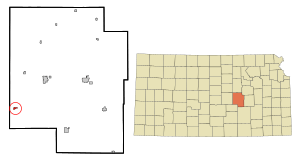
Location within Marion County and Kansas
|
|
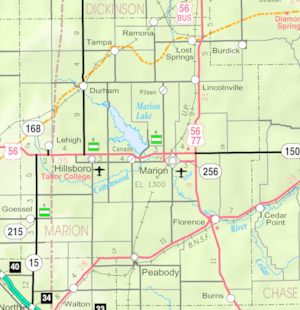
|
|
| Country | United States |
| State | Kansas |
| County | Marion |
| Township | West Branch |
| Platted | 1910 |
| Incorporated | 1952 |
| Named for | Kurt von Goessel |
| Government | |
| • Type | Mayor–Council |
| Area | |
| • Total | 0.38 sq mi (0.98 km2) |
| • Land | 0.38 sq mi (0.98 km2) |
| • Water | 0.00 sq mi (0.00 km2) |
| Elevation | 1,532 ft (467 m) |
| Population
(2020)
|
|
| • Total | 556 |
| • Density | 1,463/sq mi (567/km2) |
| Time zone | UTC-6 (CST) |
| • Summer (DST) | UTC-5 (CDT) |
| ZIP code |
67053
|
| Area code | 620 |
| FIPS code | 20-26750 |
| GNIS ID | 2394920 |
Goessel is a small city in Marion County, Kansas, United States. It's home to about 556 people, based on the 2020 census. The city is named after Captain Kurt von Goessel, a German captain who sadly died when his ship, the Elbe, sank in the English Channel. Goessel is located about 11 miles north of North Newton, right next to the K-15 highway.
History of Goessel
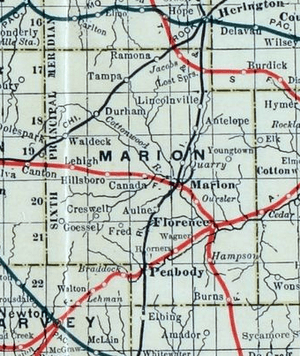
How Goessel Began
For thousands of years, the Great Plains of North America were home to nomadic Native American tribes. Later, from the 16th to the 18th centuries, France claimed much of this land. In 1762, France secretly gave this land to Spain.
Then, in 1802, Spain gave most of the land back to France. A year later, in 1803, the United States bought a huge area, including what is now Kansas, from France. This was part of the Louisiana Purchase, a very important deal for the U.S.
Kansas became the 34th U.S. state in 1861. In 1855, Marion County, where Goessel is today, was officially created.
Mennonite Settlers Arrive
In 1874, many Plautdietsch-speaking Mennonites came to south-central Kansas. They were looking for religious freedom and a place to keep their traditions alive. Twelve Mennonite leaders from the Russian Empire visited both Manitoba (Canada) and Kansas. Eight of them chose Kansas as their new home.
A large group of these Mennonites traveled to the United States on ships called the Teutonia and Cimbria. The group that sailed on the Cimbria, known as the Alexanderwohl group, settled around what is now Goessel.
They first lived in eight small villages. One of these villages was called Gnadenfeld, which means "Grace Field." This village was located exactly where Goessel stands today. After a few years, families moved to their own larger plots of land nearby.
Naming the Town
It took some time for a trading center to grow. The first public building in Goessel was a Mennonite Brethren church, built in 1890. A doctor named Peter Richert opened an office in 1891. He later became the postmaster. Dr. Richert read a story about Captain Kurt von Goessel, whose ship sank in the English Channel. He liked the name and suggested it for the new post office. The name Goessel was officially accepted on April 13, 1895.
Goessel in the 20th Century
In 1910, Goessel was officially planned out, and about 100 people lived there. By 1952, Goessel became an incorporated city, meaning it had its own local government, and its population grew to 260. By 2010, the population was 539.
On March 13, 1990, a very strong F5 tornado hit Goessel. This tornado was so powerful that some weather experts thought it was one of the strongest ever recorded at that time.
Today, Goessel is proud to be home to the Mennonite Heritage Museum. This museum has eight buildings filled with items that show what life was like for early Mennonite families, their farms, schools, and churches.
Geography and Weather
Goessel is located in the Great Plains region of Kansas. The city covers a total area of about 0.35 square miles (0.91 square kilometers), all of it land. The county line is just one mile west of Goessel.
Climate in Goessel
The weather in Goessel includes hot and humid summers. Winters are usually mild to cool, but sometimes they can have very cold periods.
People of Goessel
| Historical population | |||
|---|---|---|---|
| Census | Pop. | %± | |
| 1960 | 327 | — | |
| 1970 | 386 | 18.0% | |
| 1980 | 421 | 9.1% | |
| 1990 | 506 | 20.2% | |
| 2000 | 565 | 11.7% | |
| 2010 | 539 | −4.6% | |
| 2020 | 556 | 3.2% | |
| U.S. Decennial Census | |||
Population in 2020
The 2020 United States census showed that 556 people lived in Goessel. There were 200 households and 135 families. Most people (about 93.7%) were white. A small number of people were from other races or two or more races. About 1.8% of the population was Hispanic or Latino.
About 32.5% of households had children under 18. The average household had 2.4 people. The average family had 3.1 people. The median age in the city was 42.6 years old. This means half the people were younger than 42.6, and half were older.
Population in 2010
In 2010, Goessel had 539 people living in 206 households. Most residents (97%) were White. The median age in the city was 48.6 years. About 22.6% of residents were under 18 years old.
Fun Things to Do in Goessel
Local Events
- Goessel Threshing Days: This event happens at the Mennonite Heritage and Agricultural Museum. You can see old-fashioned threshing demonstrations, which show how farmers used to separate grain from plants. Many antique tractors are also on display. You can even try traditional Mennonite food!
- Goessel Harvest Festival: Another fun local festival celebrating the harvest season.
Places to Visit

- Mennonite Heritage and Agricultural Museum: Located at 200 N Poplar St. This museum opened in 1974. It has eight buildings that show what life was like for the Mennonite immigrants who settled in the Goessel area.
- Alexanderwohl Mennonite Church: You can find this historic church about 1 mile north of Goessel on K-15 Highway.
- Kansas Historical Marker - The Mennonites In Kansas: This sign, also 1 mile north on K-15 Highway, tells the story of Mennonites in Kansas.
Education in Goessel
Public Schools
The Goessel USD 411 public school district serves the community.
- Goessel High School, 100 E Main St.
- Goessel Junior High School, 100 E Main St.
- Goessel Elementary School, 500 E Main St.
School Sports
The Goessel High School teams are called the Bluebirds. They offer many sports, including football, volleyball, cross country, basketball, golf, and track and field. Goessel Jr/Sr. High School is part of the Wheat State League and the Kansas State High School Activities Association (KSHSAA).
They have won several championships:
- 1976 Boys Cross Country - Class 1A
- 1988 Boys Basketball - Class 1A
- 2015 Scholars' Bowl - Class 1A
- 2015 Volleyball - Class 1A
- 2016 Girls Cross Country - Class 1A
Local Library
Each school in USD 411 has its own library for students. The city also has the Goessel Public Library at 101 South Cedar Street. This library is part of the North Central Kansas Libraries System, which means you can borrow books from other libraries too! The library offers programs, materials, computers, and free 24-hour internet access for everyone in town.
Media and News
Print Media
- Hillsboro Free Press: A free newspaper for the larger Marion County area.
- The Newton Kansan: A regional newspaper from Newton.
Radio and TV
Goessel can receive many radio stations and digital TV channels from the Wichita-Hutchinson area. You can also get cable TV and satellite TV.
City Services
Transportation
The K-15 highway runs right along the east side of Goessel, making it easy to travel to and from the city.
Utilities and Services
Goessel has various services to help its residents:
- Internet: Provided by companies like Moundridge Telephone Company (DSL), Pixius Communications (wireless), and satellite providers like HughesNet.
- TV: Available through cable (Moundridge Telephone Company), satellite (DirecTV, Dish Network), and local digital TV stations.
- Phone: Landline service is provided by Moundridge Telephone Company.
- Electricity: Supplied by Westar Energy.
- Natural Gas: Provided by Kansas Gas Service.
- Water: The city's water comes from Marion County RWD #4.
- Sewer and Trash: These services are managed by the City of Goessel.
Famous People from Goessel
- Ira Anders (born 1942), a politician.
- Wes Buller (1928-2018), a football coach.
- Shirley Knight (1936-2020), a well-known stage, screen, and television actress who was nominated for an Academy Award.
- Duane D. Thiessen (born 1951), a Major General in the United States Marine Corps.
See also
 In Spanish: Goessel para niños
In Spanish: Goessel para niños



